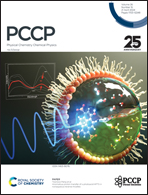Is azulene's local aromaticity and relative stability driven by the Glidewell–Lloyd rule?†
Abstract
The local aromaticity of azulene has been studied to understand their electronic properties. For this purpose, we have used the magnetic criterion through magnetically induced current density maps, ring current strengths, NICSzz(1), and the bifurcation value of three-dimensional surfaces of NICSzz. On the other hand, the delocalization criterion was used by calculating the MCI and ELFπ. The results show that the five-membered ring (5-MR) is more aromatic than the seven-membered ring (7-MR) and more aromatic than the free C5H5− ring. The opposite case is seen for the seven-membered ring, which is less aromatic than the free C7H7+. The local aromatic rings in azulene are formed due to an intramolecular electron transfer from the 7-MR to the 5-MR. In addition, the proposed resonance structures that allow explaining the properties of azulene, such as the dipole moment or the relative stability (in comparison to other isomers), show a preference for the formation of 5-MRs; for this reason, it is possible to conclude that the aromaticity and relative stability of azulene is driven by the Glidewell–Lloyd rule.



 Please wait while we load your content...
Please wait while we load your content...